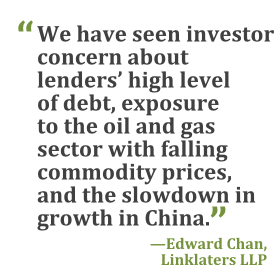Europe's biggest banks face a stress test this year that willgauge their capacity to withstand economic contraction at home,shocks in major emerging markets, and declines in property marketsand commodities. None of them will pass—or fail.
|The test has no pass mark to identify capital shortfalls, abreak from previous practice, because banks have emerged from thefinancial crisis, the European Banking Authority (EBA) said.Supervisors such as the European Central Bank (ECB) and the Bank ofEngland (BOE) will factor the results into their annual assessmentsof lenders. Both have said the industry is well capitalized andthey won't be imposing significant new capital requirements.
| Theadverse scenario for this year's health check, published onWednesday by the London-based EBA, exposes banks to recessions inthe European Union this year and next followed by anemic growth in2018. It assumes gross domestic product rising 3.4 percent in Chinathis year, compared with a baseline projection of 6.5 percent. InRussia and Brazil, 2016 GDP plunges 8.1 percent and 5.9 percent,respectively.
Theadverse scenario for this year's health check, published onWednesday by the London-based EBA, exposes banks to recessions inthe European Union this year and next followed by anemic growth in2018. It assumes gross domestic product rising 3.4 percent in Chinathis year, compared with a baseline projection of 6.5 percent. InRussia and Brazil, 2016 GDP plunges 8.1 percent and 5.9 percent,respectively.
“These stress tests should have limited impact on the banks'capital plans,” KBW bank analysts said in a research note after theEBA publication on Wednesday. “These scenarios are not that farfrom the fears priced in today in bank valuations.”
|Commodity prices also take a hit in the EBA's adverse scenario,with oil prices down about 48 percent this year from the baselineprojection of about US$54 a barrel. Brent crude for Aprilsettlement lost as much as 56 cents, or 1.6 percent, to $33.85 abarrel Thursday morning on the London-based ICE Futures Europeexchange. Prices remain about 44 percent below baseline levels in2017 and 2018 in the EBA test.
|The scenario projects that long-term interest rates in the EUwould be higher by 71 basis points in 2016, 80 basis points in2017, and 68 basis points in 2018. Meanwhile, the test includes anoverall decline of 6 percent in house prices, a supplemental shockof 7.5 percent affecting all EU countries and additionalhouse-price declines in Denmark, Ireland, and Slovakia.
|In 2014, to pass a baseline scenario, banks had to maintain aratio of capital to risk-weighted assets of 8 percent. In theadverse scenario, which allowed lenders to run down capitalbuffers, the ratio was 5.5 percent. Twenty-four banks failed thattest with a capital shortfall of 24.6 billion euros ($27.1billion).
Stress Tests to Keep Banks on Their Toes
“The objective of the crisis stress tests was to identifypossible capital shortfalls and require immediate recapitalizationactions,” the EBA said. “As banks have now moved to a moresteady-state setting, the aim of the 2016 exercise is rather toassess remaining vulnerabilities and understand the impact ofhypothetical adverse market dynamics on banks.”
|The 51-bank exam, whose results will be published early in thethird quarter, comes after banks including Societe Generale SA,HSBC Holdings Plc, and Standard Chartered Plc reporteddisappointing earnings that raised questions among investors andregulators about lenders' ability to make a profit.
||“Since the start of the year we have seen investor concern aboutlenders' high level of debt, exposure to the oil and gas sectorwith falling commodity prices, and the slowdown in growth inChina,” said Edward Chan, partner at Linklaters LLP in London. “Thestress tests are designed to ensure that banks have a sustainablebusiness model in the face of such turbulence.”
|Daniele Nouy, head of the ECB's oversight arm, said on Feb. 23that her chief priority in 2016 is reviewing how lenders arechanging their business models and investing in riskier assets toensure they can remain profitable.
|The ECB and the BOE have said this year that the industry iswell capitalized and they won't be imposing significant new capitalrequirements. Nouy said it's not the ECB's intention to raisecapital requirements indefinitely. With regard to bank-specificrequirements set by supervisors, “we expect the banks to hold insteady state,” she said. “All things being equal, supervisoryrequirements will not be increased further.”
|Even without the threat of capital gaps being revealed, stresstests are useful to “keep banks on their toes a bit,” said RobertMontague, senior financials analyst for ECM Asset Management, partof Wells Fargo Asset Management which has $490 billion undermanagement. The assessments are “a good thing in that they makecomparable data available across the piece,” he said.
|The EBA said the data from the tests will help regulatorssupervise individual lenders, “where mitigating actions may also beconsidered.”
|This year's test pits banks' end-2015 balance sheets against acommon macroeconomic baseline and an adverse scenario. Itincludes banks from 15 countries and covers about 70 percent of theindustry by total consolidated assets as of end-2014.
|Copyright 2018 Bloomberg. All rightsreserved. This material may not be published, broadcast, rewritten,or redistributed.
Complete your profile to continue reading and get FREE access to Treasury & Risk, part of your ALM digital membership.
Your access to unlimited Treasury & Risk content isn’t changing.
Once you are an ALM digital member, you’ll receive:
- Critical Treasury & Risk information including in-depth analysis of treasury and finance best practices, case studies with corporate innovators, informative newsletters, educational webcasts and videos, and resources from industry leaders.
- Exclusive discounts on ALM and Treasury & Risk events.
- Access to other award-winning ALM websites including PropertyCasualty360.com and Law.com.
*May exclude premium content
Already have an account? Sign In
© 2024 ALM Global, LLC, All Rights Reserved. Request academic re-use from www.copyright.com. All other uses, submit a request to [email protected]. For more information visit Asset & Logo Licensing.







